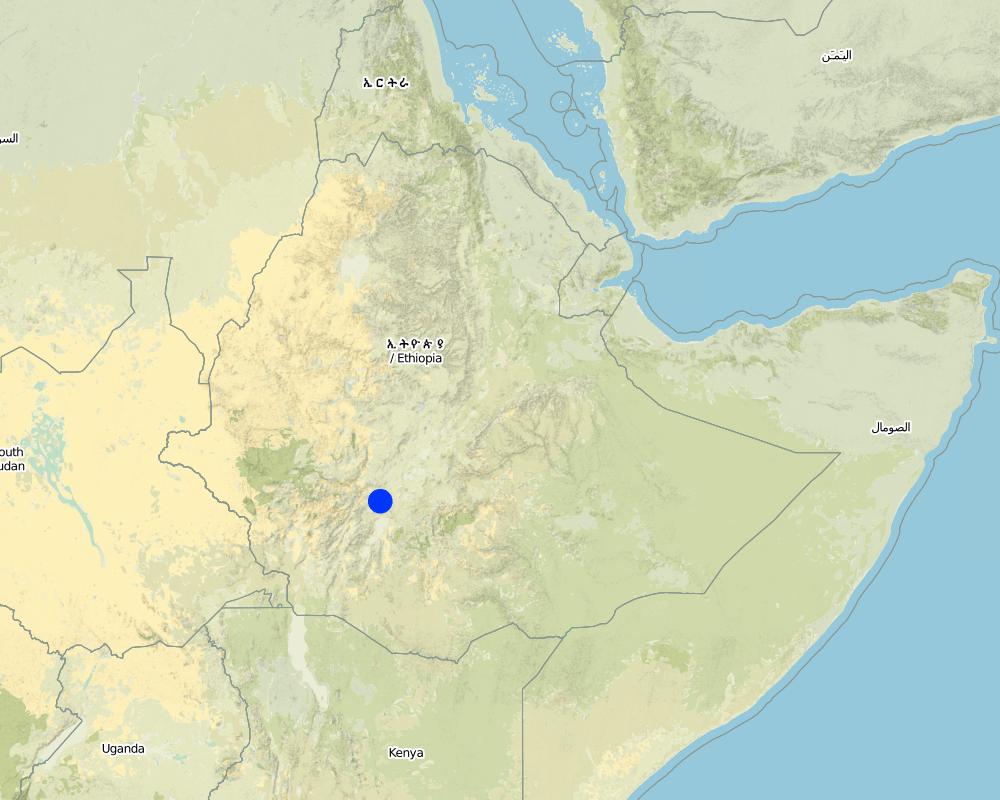Local level particpatory planning approaches with incentive. [埃塞俄比亚]
- 创建:
- 更新:
- 编制者: Philippe Zahner
- 编辑者: –
- 审查者: Fabian Ottiger
approaches_2382 - 埃塞俄比亚
查看章节
全部展开 全部收起1. 一般信息
1.2 参与方法评估和文件编制的资源人员和机构的联系方式
SLM专业人员:
SLM专业人员:
有助于对方法进行记录/评估的机构名称(如相关)
Swiss Agency for Development and Cooperation (DEZA / COSUDE / DDC / SDC) - 瑞士有助于对方法进行记录/评估的机构名称(如相关)
FAO Food and Agriculture Organization (FAO Food and Agriculture Organization) - 意大利1.3 关于使用通过WOCAT记录的数据的条件
编制者和关键资源人员接受有关使用通过WOCAT记录数据的条件。:
是
2. SLM方法的描述
2.1 该方法的简要说明
All participants that way and means used to promote and implement sWC Technology Support more sustainable.
2.2 该方法的详细说明
该方法的详细说明:
Aims / objectives: Gradually improve the livelhood of most vulnerable house hold by wise utilization and conservation of natural Resource with incentives to improve gully degradation, to improve production and productivity by conserving the natural resource, to creat incime generating activities there by improve income of households, to empower local farmers and users how to evaluate, monitor and plan to get forage crops from vegetation, to be aware of land degradation. 1. suggetion, trusing the users and participants, socio economic study, environmental study/survey, implementing, evaluation and monitoring, After all the above process method is earth work Gully Deshope, the problem should adresser according that:- trusting is all participant the 1st stage, Rccording the land use and utilitation or pro and damagings the stage of implementation apply. If the land is degraded the bund strature for moisture harves with biological conservation 2nd, to contrubit the local knowledge, rule moral technology and fancial and material inputes for SWC technology for sustainable use, for transporting, for sharing responsibility, for stroring exprince.
2.5 采用该方法的国家/地区/地点
国家:
埃塞俄比亚
区域/州/省:
South Region Waterto-Bodity
Map
×2.6 该方法的开始和终止日期
注明开始年份:
2004
2.7 方法的类型
- 基于项目/方案
2.8 该方法的主要目的/目标
The Approach focused mainly on SLM with other activities (Land management - to decrease the over grazing use and encourage areas clauser and Rotion use)
to promote and implement a SWC technology to support, sustainable soil and water conservation measure for production and production and productivity and ecological balance.
The SLM Approach addressed the following problems: the main problems addressed were by human activities, gracature cause, detorestation and removal of natural vegation, over groting.
2.9 推动或妨碍实施本办法所适用的技术的条件
社会/文化/宗教规范和价值观
- 阻碍
the land use system in farming and grating is very poor
Treatment through the SLM Approach:
财务资源和服务的可用性/可得性
- 阻碍
not enough a capital buget for training for field equipment
Treatment through the SLM Approach:
机构设置
- 阻碍
the main constraints will be caltural religions
Treatment through the SLM Approach:
法律框架(土地使用权、土地和水使用权)
- 阻碍
The existing land ownership, land use rights / water rights hindered a little the approach implementation
3. 相关利益相关者的参与和角色
3.1 该方法涉及的利益相关者及其职责
- 当地土地使用者/当地社区
Working land users were mainly men (Due to the cultural and educational level and economic background.)
Woman can't land owner b/c of cultural low. Managing the land ownership of land and decision making power at mens hand. because the SWC technology encourage the poor/vuleneragle group, b/c the land of the poor is damage mostly due to economic and capital even labour and food for secrity.
- 国家政府(规划者、决策者)
Labour the administration even salary to expert.
- 国际组织
the WFP and the government
如果涉及多个利益相关者,请注明领导机构:
The land users and the woreda SWC experts, but the main sources is international specialists.
3.2 当地土地使用者/当地社区参与该方法的不同阶段
| 当地土地使用者/当地社区的参与 | 指定参与人员并描述活动 | |
|---|---|---|
| 启动/动机 | 被动 | |
| 计划 | 互动 | |
| 实施 | 外部支持 | responsibility for minor steps |
| 监测/评估 | 被动 | measurements/observations; |
| Research | 无 | measurements/observations; |
3.4 有关SLM技术选择的决策
具体说明谁有权决定选择要实施的技术:
- 主要是土地使用者,由SLM专家提供支持
解释:
the decision must Agreed by land user the plan, monitory and evaluation must be participatory (bottom-up) with land users starting from the vollage unit upto Kebel stage.
Decisions on the method of implementing the SLM Technology were made by by land users* alone (self-initiative / bottom-up). the planing is from bottom up and dicussion with the village unit community
4. 技术支持、能力建设和知识管理
4.1 能力建设/培训
是否为土地使用者/其他利益相关者提供培训?:
是
明确受训人员:
- 土地使用者
- extensionists/trainers
培训形式:
- farm visits
涵盖的主题:
For modern farmers only - for soil conservation, Agroforestry, Molticalture, animal production and handling.
4.2 咨询服务
土地使用者有权使用咨询服务吗?:
是
指明是否提供了咨询服务:
- 在土地使用者的土地上
说明/注释:
Name of method used for advisory service: Individual; Key elements: Teaching/training, Visiting; 1) Advisory service was carried out through: government's existing extension system; Extension staff: mainly government employees
Advisory service is quite adequate to ensure the continuation of land conservation activities
4.3 机构强化(组织发展)
是否通过这种方法建立或加强了机构?:
- 是,适度
具体说明机构的强化或建立程度:
- 本地
具体说明支持类型:
- 财务
- 能力建设/培训
4.4 监测和评估
监测和评估是该方法的一部分吗?:
是
注释:
bio-physical aspects were regular monitored through observations
technical aspects were ad hoc monitored through measurements
socio-cultural aspects were ad hoc monitored through observations
economic / production aspects were ad hoc monitored through observations
area treated aspects were ad hoc monitored through observations
no. of land users involved aspects were monitored through measurements
management of Approach aspects were monitored through observations
There were several changes in the Approach as a result of monitoring and evaluation: monitoring is according the plan and aim to/for successing, evaluation, by measuring observation/estimations for out put/impact, then the low method was change e.g. land management/area clause.. According th recommendation of could be change or improve the method or system.
4.5 研究
研究是该方法的一部分吗?
是
提供进一步的细节,并指出是谁做的研究:
Research was carried out on station
5. 融资和外部物质支持
5.1 该方法中SLM组成部分的年度预算
注释(例如主要的资助来源/主要捐助者):
Approach costs were met by the following donors: international (we can't define); international non-government (we don't have); national non-government (finance as budget); local community / land user(s) (only labour); other (but-for running cost for fuel and res)
5.4 信用
是否根据SLM活动的方法给予信用值?:
否
6. 影响分析和结论性陈述
6.1 方法的影响
该方法是否帮助土地使用者实施和维护SLM技术?:
- 否
- 是,很少
- 是,中等
- 是,支持力度很大
the Gully controlling and sustainable soil stracture creat the users.
该方法是否改善了阻碍SLM技术实施的土地使用权/用户权问题?:
- 否
- 是,很少
- 是,中等
- 是,支持力度很大
The problem is likely to be overcome in the near future. Yes, if there is sustainability and increasing yield.
Did other land users / projects adopt the Approach?
- 否
- 是,很少
- 是,中等
- 是,支持力度很大
Yes, they understand the change of production.
6.3 方法活动的可持续性
土地使用者能否维持通过该方法实施的措施(无外部支持的情况下)?:
- 是
7. 参考和链接
7.1 方法/信息来源
- 实地考察、实地调查
- 与土地使用者的访谈
链接和模块
全部展开 全部收起链接
无链接
模块
无模块


